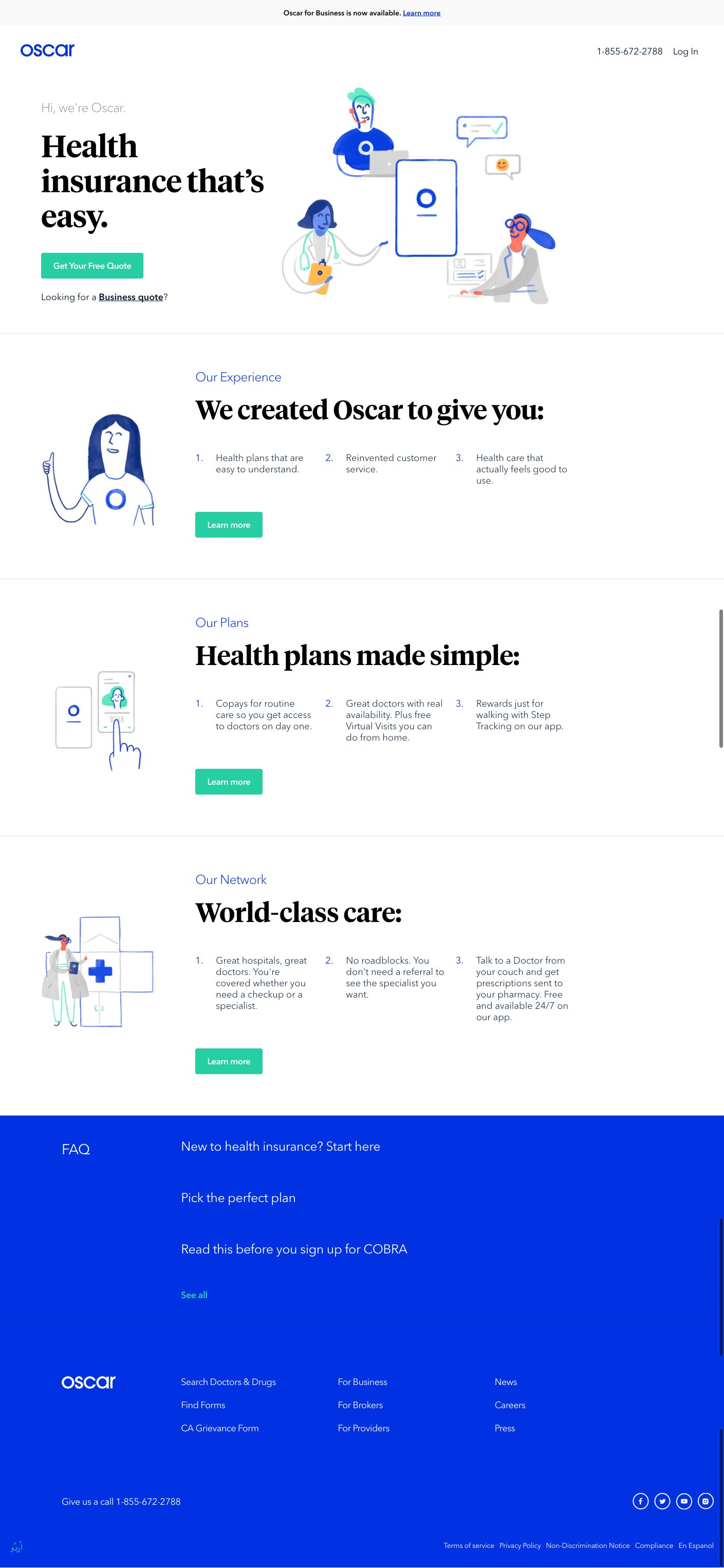March 28, 2018
Managing Growing Customer Expectations in the Health Insurance Industry

The Health Insurance industry has gone through intensifying disruptive changes in the last decade, due both to changing government policies, and the digital revolution disrupting all industries. As customer expectations evolve with these changes, insurers need to stay ahead of what is trending. As a dizzying number of new players step up to provide innovative customer experience in the health insurance industry, it has never been more critical for companies to follow suit.
Strengthening this sense of urgency were findings in the PWC study, “The Birth of the Health Care Consumer: Growing demands for choice, engagement and experience,” in which the main take away stated:
“Transparent markets and an ever-increasing range of choices mean that maintaining the status quo is no longer an option for healthcare payors and providers. Ultimately, the winners will be those firms that distinguish themselves in three ways:1) Consumer Choice2) Consumer Engagement3) Consumer Experience.”
The study also found that consumers are now willing to trust non-traditional companies, further intensifying the competition with providers that are already experts in the field of digital customer experience, and customer service like Amazon, Google, Walmart and Target.
To navigate these changes and ensure your health insurance company remains competitive, you must know what your audience needs and wants, and make it effortlessly available to them. Once you cover the basics, you can determine additional ways to delight your customers over time to stand apart from other insurance companies. For an industry that is lagging behind in adopting robust technological advances in customer experience, there is a real opportunity to outshine competitors if you take on the best strategies in the right way.

Research has also shown that there is no need to revolutionize the digital experience completely. Start with a focus on simplifying your products, services and the buying process, then build from there. As stated in this article from Strategy+Business:
“Insurers would be well advised to look at the example set by the banking sector to see how staging a gradual evolution of improving basic consumer experience and eliminating frustration can be preferable to rushing headlong into a set of futuristic technologies.”
Setting up your company for these changes starts with a few simple steps that involve understanding your prospective members, how they want to access information about your company and products, and how they want to continue to engage with you once they have become a customer.
1) Step 1: Understand the needs of your prospects
Consumers are shopping, and the company that will win them over is not necessarily the one with the best or cheapest policy. That is part of the decision-making process, but research shows, the clear winner is increasingly the company who can stand by their products and inform customers in a simple, straightforward manner.
One of the best examples of companies today that are showing they understand the shifting needs of health insurance clients is Oscar Health. How exactly did Oscar achieve these aims? According to this feature article in Forbes, “When Success Is About Doing Old Things in New Ways,” Oscar’s entire business model is customer-centric. When initially founded in 2012, the main focus was simplifying health insurance through the use of technology.
Oscar provided upfront, predictive claims based on simple data entry in a very streamlined app, which then communicated coverage using informal language while navigating consumers through their options.

Although the company has undergone a series of struggles and revenue losses, as of the end of 2017, it grew by 150% to 250K subscribers through expanding into new territories and is expected to generate $1 billion in revenue in 2018.
Step 2: Use Data to Understand Your Customers
The announcement this year of Amazon’s entry into the health insurance industry rattled health insurance leaders and came as a surprise to many. However, when you understand the shifting focus to customer-centric experience, it is no surprise that Jeff Bezos feels his company could disrupt the industry with the help of two strong allies, Warren Buffet and Jamie Dimon.
As stated in this feature article in Forbes, “Amazon could think big by simply applying the standard operating principles and capabilities that is has perfected for retail—comprehensive data, personalization, price and quality transparency, operational excellence, consumer focus and high satisfaction—to health care.”
Amazon may be working with big data, but you can start with small data in your own insurance company. Track customer interactions, understand their level of satisfaction, collect data on their needs and requests and use this data to improve the customer experience.
Although technology is greatly transforming the customer experience in health insurance, human interaction is still extremely important. Your members often want a human touch when important aspects of their lives are concerned, and when the situation may be complex or require privacy around sensitive information. As a result, many members still prefer human assistance for complications with billing or finding specialists, and many others still want human assistance for technical questions on apps, wearables, and other gadgets. And you want to make sure you are analyzing and making the most out of these personal interactions too. There’s a lot to learn from them.
One way to ramp up this kind of solution quickly is to work with a modern, business process outsourcing company that can provide fully trained, experienced customer service experts who can attend to all the needs of your clients, while also using technology to collect data on every customer interaction. The most experienced companies take additional steps to analyze that data and provide you with real, actionable knowledge on how to better serve your customers.

Step 3: Fulfill Expectations to Increase Customer Loyalty
After collecting data to understand your clients better, you must use the data to ensure your customers are happy with your service. This is how you build customer loyalty. It starts with making a website that is easy to navigate and provides as much support as customers want on demand, 24/7. The next step is to fully train and prepare your call centers to provide the personalized support and engagement customers expect.
Three main steps are needed – training the right talent and using data to fulfill current and future needs.
- Invest in high quality, modern call centers staffed with experienced, high-performing agents. The employees of your call center are the heartbeat of your insurance company. If the representative doesn’t know the answer to a question the caller has, it can damage your relationship with that customer. Therefore, it is essential that your call center staff knows your health insurance products and services thoroughly as well as the apps and tech your customers are using to access them.
- Use methods to fulfill needs as they arise. A great benefit to using data and analytics is that it can reduce the need for mass marketing. Through proper analysis, you can determine that a client is due for a physical, attaining a benchmark age, or that their area has a flu outbreak. With this information, you don’t have to blanket market for a particular process or service you provide. Instead, you can send the marketing material to the customers for whom it is relevant. This helps build the relationship with your clients by increasing the number of interactions and touch points you have with them in a given year, which increases loyalty and ultimately your bottom line.
- Use methods to identify needs before they arise. More and more insurance companies are using the data they collect to determine what a customer may need in the future. They are also using that information collectively and applying analytical tools to multiple clients to improve current policies and develop new ones.

For these steps above, even traditional health insurers can get started today and greatly improve their existing service. Insurers like Aetna, are staying up to date with the tools like “virtual assistants” which are popup messages on their website that ask visitors if they have any questions. The app then directs them to the answers. These are becoming commonplace in the insurance industry and is an easy first step to making your website more customer-centric. The ability to browse your site and find answers for themselves gives the consumer confidence in your company and strengthens the customer experience.
Aetna has done a great job with small changes to make their website easier to use. They installed a virtual assistant called “Ask Ann,” which is now accessed over 2,500 times per day. This has helped reduce the volume of customer service calls 29%. By making it easier for customers to understand your products and services, and find answers they may have, your call center employees can focus on more serious concerns and your customer service ratings increase.
When you take the tools available to the health insurance industry and apply them to the resources you already have, you can easily increase your customers’ experience incrementally. The health insurance industry has traditionally been one of the most impersonal industries as it catered to large companies and corporations, and not the end consumer. It has also historically been the type of product you would purchase and not think about much afterward. The only personal communication between the customer and insurance company was usually for a premium renewal. Building a bridge of personalization through the use of technology and highly trained customer service centers, you will keep your customers from searching your competition for a better experience.
To learn more about enhancing your call center, read about the BPO services with CGS here.


